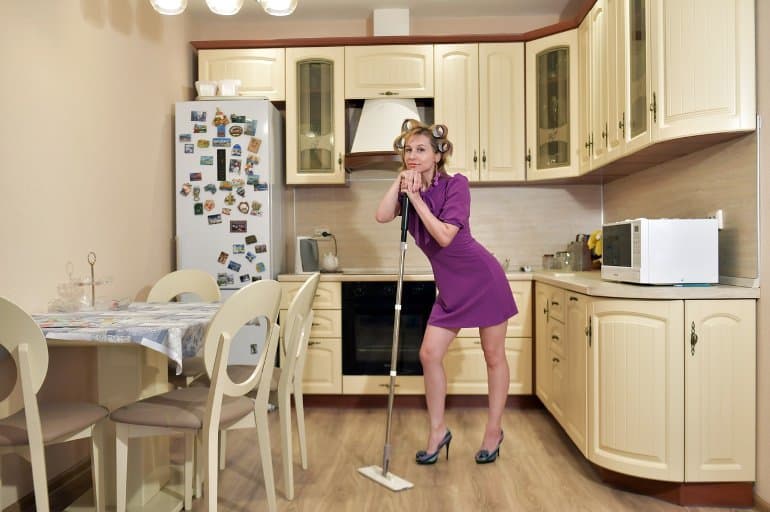Summary: Spending time performing household chores may help to improve brain health, especially for older adults. Researchers found older adults who spent more time engaging in housework had greater brain volume, specifically in the frontal lobe and hippocampus, brain areas associated with memory and cognition.
Source: Baycrest Center for Geriatric Care
Engaging in household chores may be beneficial for brain health in older adults. In a recent Baycrest study, older adults who spent more time on household chores showed greater brain size, which is a strong predictor of cognitive health.
“Scientists already know that exercise has a positive impact on the brain, but our study is the first to show that the same may be true for household chores,” says Noah Koblinsky, lead author of the study, Exercise Physiologist and Project Coordinator at Baycrest’s Rotman Research Institute (RRI).
“Understanding how different forms of physical activity contribute to brain health is crucial for developing strategies to reduce the risk of cognitive decline and dementia in older adults.”
In this study, published in the journal BMC Geriatrics, the researchers looked at the links between household chores, brain volume and cognition in a group of 66 cognitively healthy older adults living in the community. The participants attended three assessment visits at Baycrest Hospital, including a health evaluation, structural brain imaging and cognitive assessment.
Participants were asked about the time they spent on household chores, such as tidying, dusting, meal preparation and clean up, shopping, heavy housework, yard work, home repairs and caregiving.
The researchers found that older adults who spent more time engaging in such activities had greater brain volume, regardless of how much exercise they did. This was observed in the hippocampus, which plays a major role in memory and learning, and the frontal lobe, which is involved in many aspects of cognition.
Although it is possible that individuals with larger brains are more likely to take up household chores, there could be several explanations for the brain benefits of household physical activity.
First, we know that heart health is closely tied to brain health. It could be that household chores have a similar effect on the heart and blood vessels as low-intensity aerobic exercise.
Second, the planning and organization involved in household chores may promote the formation of new neural connections over time, even as we age.

Third, it could be that the older adults who engaged in more household chores spent less time being sedentary, which has been shown to be associated with negative health outcomes, including poor brain health.
“Besides helping to guide physical activity recommendations for older adults, these findings may also motivate them to be more active, since household chores are a natural and often necessary aspect of many people’s daily lives, and therefore appear more attainable,” says Dr. Nicole Anderson, Senior Scientist at the RRI, Director of the Ben and Hilda Katz Interprofessional Research Program in Geriatric and Dementia Care, and senior author of this study.
This study was funded in part by the Canadian Institutes of Health Research (CIHR).
As a next step, the researchers would like to assess household physical activity more objectively using wearable technology. With additional funding, they could also plan controlled trials with the aim of increasing individuals’ household activity and studying brain changes over time.
About this brain health and aging research news
Source: Baycrest Center for Geriatric Care
Contact: Sophie Boisvert-Hearn – Baycrest Center for Geriatric Care
Image: The image is in the public domain
Original Research: Open access.
“Household physical activity is positively associated with gray matter volume in older adults” by Noah D. Koblinsky, Liesel-Ann C. Meusel, Carol E. Greenwood and Nicole D. Anderson. BMC Geriatrics
Abstract
Household physical activity is positively associated with gray matter volume in older adults
Background
Total physical activity is positively associated with brain volume and cognition in older adults. While we have ample evidence that recreational physical activity influences brain health, the contributions of other daily activities are less understood. In particular, the associations between household physical activity and brain health in older adults is underexplored. The purpose of this study was to identify associations between household physical activity, brain volume, and cognition in a sample of cognitively unimpaired older adults.
Methods
We report data from 66 cognitively unimpaired older adults (71 ± 4 years) who participated in a health evaluation, cognitive assessment, and structural brain imaging. Physical activity was assessed using the Phone-FITT questionnaire and separated into household and recreational physical activity.
We quantified whole brain volume, gray matter volume, and white matter volume, and assessed cognitive performance in four domains: memory, working memory/attention, processing speed, and executive function.
Associations between physical activity, brain volume, and cognition were investigated in an omnibus approach using two multivariate analysis of variance (MANOVA) models.
The first model assessed the associations between physical activity and brain volume adjusting for age, sex, Framingham Risk score (FRS) and intracranial volume.
The second model assessed the associations between physical activity and overall cognitive performance adjusting for age, sex, FRS and education.
Post hoc regression analyses were conducted to investigate significant MANOVA results.
We also conducted further regression analyses to investigate associations with hippocampal and frontal lobe volume.
Results
Household, but not recreational, physical activity was positively associated with brain volume measurements (F = 3.07, p = .035), specifically gray matter volume (t = 2.51, p = .015). Further exploratory analyses identified that household physical activity was associated with hippocampal (p = .015) and frontal lobe (p = .010) volume. No significant relationships were observed between household or recreational physical activity and cognition.
Conclusion
Time spent engaging in household physical activity was positively associated with brain volume, specifically gray matter volume, in older adults. Highlighting the benefits associated with household chores may motivate older adults to be more active by providing a more attainable, low risk form of physical activity.







